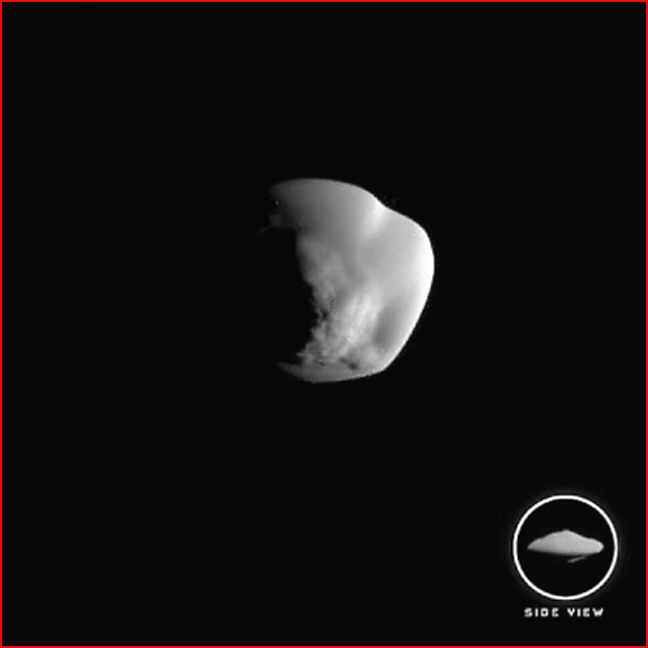
home •
about •
essential guide •
picture of the day •
thunderblogs •
news •
multimedia •
predictions •
products •
get involved •
contact
picture of the day archive subject index
Atlas, a small lens-shaped moon of Saturn. Credit: NASA/JPL Cassini-Huygens mission.
Oct 26, 2007
Atlas, Saturn's Lenticular MoonIf the equatorial ridge of Iapetus suggests electrical activity then Atlas reveals the potential extremity of that force.
In several past Picture of the Day articles, we have discussed the electrical origin of Saturn's moon, Iapetus and compared it to formations found on Earth. The equatorial ridge that girdles the moon is indicative of compression effects that occur when current flows through plasma or electrically conductive solid objects. The z-pinch (or Bennett pinch) phenomenon forces the material into a smaller and smaller volume, squeezing it into a characteristic distortion at right angles to the energy flow. The structure of Atlas, one of Saturn's smallest moons, exhibits a dramatic example of that potential power.
Richard J. Terrile discovered Atlas after analyzing images returned by the Voyager 1 spacecraft during its flyby of Saturn on November 12, 1980. Atlas was named after one of the mythological Titans, the son of Iapetus. It is 40 kilometers long by 20 kilometers wide and rotates around its flattened plane. Atlas appears to act as a "shepherd moon" to Saturn's A ring along with its sibling, Pan, sharpening the edges of the ring and maintaining its width.
Conventional theory proposes that Atlas was formed through a process of accretion. The tiny body probably originated as a piece of space debris that was captured by Saturn's enormous gravity. As it passed in and out of Saturn's ring plane, its miniscule gravitational field attracted particles from the rings and deposited them on the surface of the moon. Supposedly, this 'particulate drizzle' has built-up the edges of Atlas, creating the moon's exceptional shape and erasing any trace of cratering. It has also left a thick deposit of dust uniformly distributed over its surface obscuring the 'original' form.
As we have noted in the past, Saturn and its ring system is not a neutral environment but is highly charged and electrically active. The rings possess many features that cannot be explained by gravity alone, or the influence of the many moonlets orbiting with them. The "spokes" that seem to hover above the ring plane, the thousands of bands that are sorted by their chemical composition, the x-ray light that they emit - all of those characteristics decry the standard explanations for their inconsistency.
Since Atlas exists inside the electromagnetic fields of its parent then its influence on Saturn's rings could be considered an electrical phenomenon, as well. Present theories propose that "shepherd moons" push and pull the individual rings as they orbit together. Atlas and Pan orbit just outside and just inside the A ring. As they play catch up with each other in their orbits, they alternately push the ring particles in toward Saturn and then pull them out and away, keeping the ring stable. The gravitational fields of the two moons may also create the Encke Gap, as the theory states.
The Electric Universe model sees the Saturnian system differently. The charged moons and the charged rings are alternately repelling and attracting each other as they move through the plasma sheath surrounding Saturn. Electric discharges from the giant planet might be what created the rings and moons in the first place, so electricity in its myriad manifestations could be responsible for their arrangement.
At some point in the past, according to EU theory, Saturn experienced a violent upheaval that saw plasma discharges and incredibly intense auroral curtains sweep through the solar system. Any celestial bodies within the range of the outburst would have been hammered by powerful currents, bombarded with intense radiation, heated and half-melted and then blasted with lightning bolts as big as continents. All of that energy could have created the distinctive shape of Atlas, as well.
By Stephen Smith
___________________________________________________________________________Please visit our Forum
The Electric Sky and The Electric Universe available now!

|
|

|
EXECUTIVE EDITORS:
David Talbott, Wallace Thornhill
MANAGING EDITORS:
Steve Smith, Mel Acheson
CONTRIBUTING EDITORS: Michael Armstrong, Dwardu Cardona,
Ev Cochrane,
C.J. Ransom, Don Scott, Rens van der Sluijs, Ian Tresman
WEBMASTER: Brian Talbott
Copyright 2007: thunderbolts.info
![]()
home •
thunderblogs •
forum •
picture of the day •
resources •
team •
updates •
contact us

